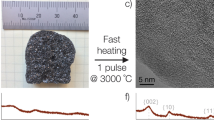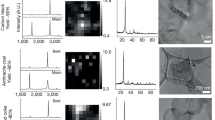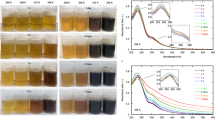Abstract
THE accompanying photographs (Fig. 1) illustrate an observation made while studying the oxidation of graphite. A thin flake of Ceylon graphite (99.9 per cent carbon) was oxidised during many hours at 900° C. in a stream of oxygen at 1 mm. pressure. (The product is about 50 per cent carbon dioxide and 50 per cent carbon monoxide.) Photomicrographs were taken at intervals ; the two reproduced show the state of the flake when probably more than four-fifths of the original graphite had been oxidised away. In both, the flake is viewed, roughly, perpendicularly to the cleavage plane, A by light reflected from this plane, B by transmitted light.
This is a preview of subscription content, access via your institution
Access options
Subscribe to this journal
Receive 51 print issues and online access
$199.00 per year
only $3.90 per issue
Buy this article
- Purchase on Springer Link
- Instant access to full article PDF
Prices may be subject to local taxes which are calculated during checkout
Similar content being viewed by others
Author information
Authors and Affiliations
Rights and permissions
About this article
Cite this article
GREER, E., TOPLEY, B. Attack of Oxygen Molecules upon Highly Crystalline Graphite. Nature 129, 904–905 (1932). https://doi.org/10.1038/129904b0
Issue Date:
DOI: https://doi.org/10.1038/129904b0
This article is cited by
-
Anisotropy of chemical activity in graphite toward oxidizing agents
Theoretical and Experimental Chemistry (1972)
-
Topography of Kish Crystals and the Effect of Oxidation in Air
Nature (1963)
Comments
By submitting a comment you agree to abide by our Terms and Community Guidelines. If you find something abusive or that does not comply with our terms or guidelines please flag it as inappropriate.



